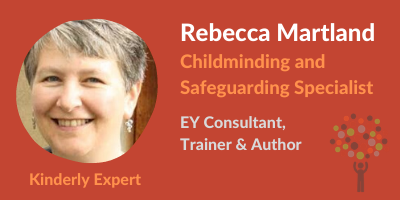Coronavirus has hit an already struggling childcare sector hard. According to childcare.co.uk, 15% of the UK’s early years providers are set to permanently close as a result of coronavirus. A survey of more than 6,000 providers conducted in May 2020 by the Early Years Alliance suggested starker figures, with 25% of respondents saying it was ‘somewhat unlikely’ or ‘very unlikely’ that they would be operating in 12 months’ time, and that 69% of providers expect to operate at a loss over the next six months. Figures collated by Ceeda show that around three-quarters of all settings are currently open but with occupancy averaging at just 38% in the week commencing 1 June compared to 77% occupancy in the same period last year.
With these figures in mind, it is imperative that settings begin to rebuild their occupancy as quickly as possible if permanent closures are to be avoided. In this blog, Early Years Consultant and trainer Rebecca Martland explores why occupancy levels remain low and in part 2, will examine some of the ways in which providers can address this issue.
Some parents are choosing not to send their children to school or childcare even though they are eligible to do so. An Early Years Alliance survey of 4,490 parents of under-fives found that only 45% were planning to return to childcare when settings reopened from 1 June. The most commonly given reasons for not returning were:
Fear for people’s safety is evidently a major factor influencing parent’s decisions not to return but there are other possible reasons for their reluctance, that might include:

Many of the reasons for existing parents not returning also apply to potential new parents. Additional factors might include:
Settings need to understand parents’ reasons in order to be able to respond appropriately. Having positive, open communication channels in place is essential. Use these to keep in touch with parents and children who are not attending and to discuss what the concerns or reasons for this are. Consider the following to keep in touch:

To help alleviate parental anxieties have clear, jargon-free policies and procedures that explain how the setting is now organised:
These can all be discussed via a Zoom meeting, or you can invite small groups of parents (no more than 6 people, including staff and children), perhaps after hours, to a meeting in your outdoor area, if the requisite distancing measures can be implemented. Written documents can be provided on a website or via a Facebook group for parents. Keep these short and use bullet points for clarity.

It is important to be flexible in your approach at this time – one size rarely fits all, even more so in the current situation. Restrictive terms and conditions will not endear you to parents and may not be enforceable if deemed unfair. Parents will appreciate your efforts to meet their individual needs and circumstances. Distinguish between Government guidance, where you can take a proportionate, flexible approach, and Government requirements where you cannot deviate.
You may need to have a long-term plan to increase numbers, especially if concerns around family health affect you directly, or current guidance around bubbles restricts the space available, and consequently the numbers of children you can safely accommodate. Updated guidance, published 2 July, states that from 20 July the requirement to keep children in small, consistent groups will be removed although settings will still be asked to minimise mixing where possible.
In part 2 of this blog, I will explore ways in which providers can overcome some of the issues and barriers discussed, including retaining existing families and recruiting new ones in order to ensure sustainability.
References

About Rebecca
Rebecca has 20 years’ experience in the early years sector: as a childminder, she has received an Outstanding grade from Ofsted for four consecutive inspections. She is an Early Years consultant, trainer, author and Nursery World Awards judge. She is also a qualified teacher and Early Years Professional.